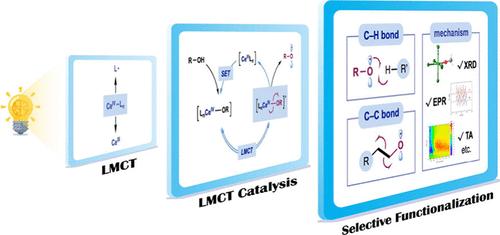当前位置:
X-MOL 学术
›
Acc. Chem. Res.
›
论文详情
Our official English website, www.x-mol.net, welcomes your
feedback! (Note: you will need to create a separate account there.)
Ligand-to-Metal Charge Transfer (LMCT) Catalysis: Harnessing Simple Cerium Catalysts for Selective Functionalization of Inert C–H and C–C Bonds
Accounts of Chemical Research ( IF 16.4 ) Pub Date : 2024-09-18 , DOI: 10.1021/acs.accounts.4c00510 Qing An 1 , Liang Chang 2 , Hui Pan 1 , Zhiwei Zuo 1
Accounts of Chemical Research ( IF 16.4 ) Pub Date : 2024-09-18 , DOI: 10.1021/acs.accounts.4c00510 Qing An 1 , Liang Chang 2 , Hui Pan 1 , Zhiwei Zuo 1
Affiliation

|
Chemists have long pursued harnessing light energy and photoexcitation processes for synthetic transformations. Ligand-to-metal charge transfer (LMCT) in high-valent metal complexes often triggers bond homolysis, generating oxidized ligand-centered radicals and reduced metal centers. While photoinduced oxidative activations can be enabled, this process, typically seen as photochemical decomposition, remains underexplored in catalytic applications. To mitigate decomposition during LMCT excitation, we developed a catalytic cycle integrating in situ coordination, LMCT, and ligand homolysis to activate ligated alcohols transiently into alkoxy radicals. This catalytic approach leverages Ce(IV) LMCT excitation and highly reactive alkoxy radical intermediates for selective functionalizations of C(sp3)–H and C(sp3)–C(sp3) bonds under mild conditions. In this Account, we discuss these advancements, highlighting the practical utility of cost-effective cerium salts as catalysts and their potential to develop innovative transformations, addressing long-standing synthetic challenges.
中文翻译:

配体-金属电荷转移 (LMCT) 催化:利用简单的铈催化剂对惰性 C-H 和 C-C 键进行选择性功能化
长期以来,化学家一直在寻求利用光能和光激发过程进行合成转化。高价金属络合物中的配体-金属电荷转移 (LMCT) 通常会触发键均解,产生氧化的配体中心自由基和还原的金属中心。虽然可以启用光诱导氧化激活,但这一通常被视为光化学分解的过程在催化应用中仍未得到充分探索。为了减轻 LMCT 激发过程中的分解,我们开发了一种催化循环,将原位配位、LMCT 和配体同解相结合,以将连接的醇瞬时活化为烷氧基自由基。这种催化方法利用 Ce(IV) LMCT 激发和高反应性烷氧基自由基中间体在温和条件下对 C(sp3)-H 和 C(sp3)-C(sp3) 键进行选择性官能化。在本专题中,我们讨论了这些进展,强调了具有成本效益的铈盐作为催化剂的实际用途及其开发创新转化的潜力,以应对长期存在的合成挑战。
更新日期:2024-09-18
中文翻译:

配体-金属电荷转移 (LMCT) 催化:利用简单的铈催化剂对惰性 C-H 和 C-C 键进行选择性功能化
长期以来,化学家一直在寻求利用光能和光激发过程进行合成转化。高价金属络合物中的配体-金属电荷转移 (LMCT) 通常会触发键均解,产生氧化的配体中心自由基和还原的金属中心。虽然可以启用光诱导氧化激活,但这一通常被视为光化学分解的过程在催化应用中仍未得到充分探索。为了减轻 LMCT 激发过程中的分解,我们开发了一种催化循环,将原位配位、LMCT 和配体同解相结合,以将连接的醇瞬时活化为烷氧基自由基。这种催化方法利用 Ce(IV) LMCT 激发和高反应性烷氧基自由基中间体在温和条件下对 C(sp3)-H 和 C(sp3)-C(sp3) 键进行选择性官能化。在本专题中,我们讨论了这些进展,强调了具有成本效益的铈盐作为催化剂的实际用途及其开发创新转化的潜力,以应对长期存在的合成挑战。


















































 京公网安备 11010802027423号
京公网安备 11010802027423号